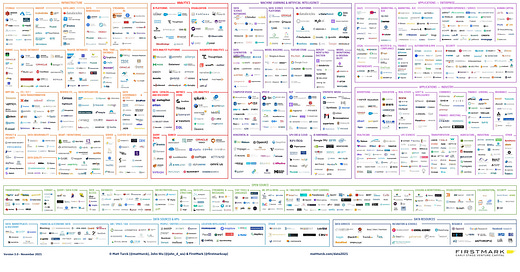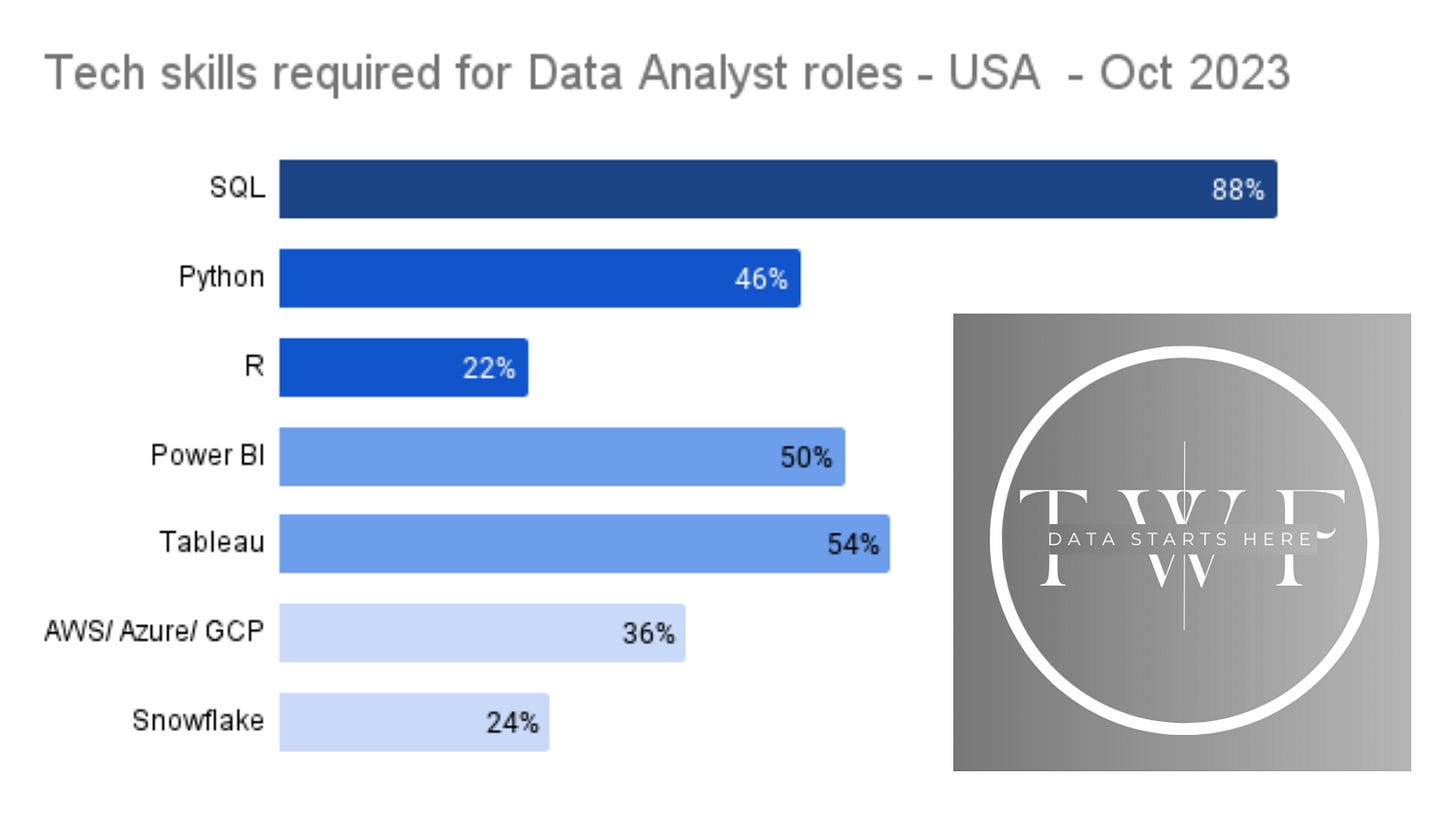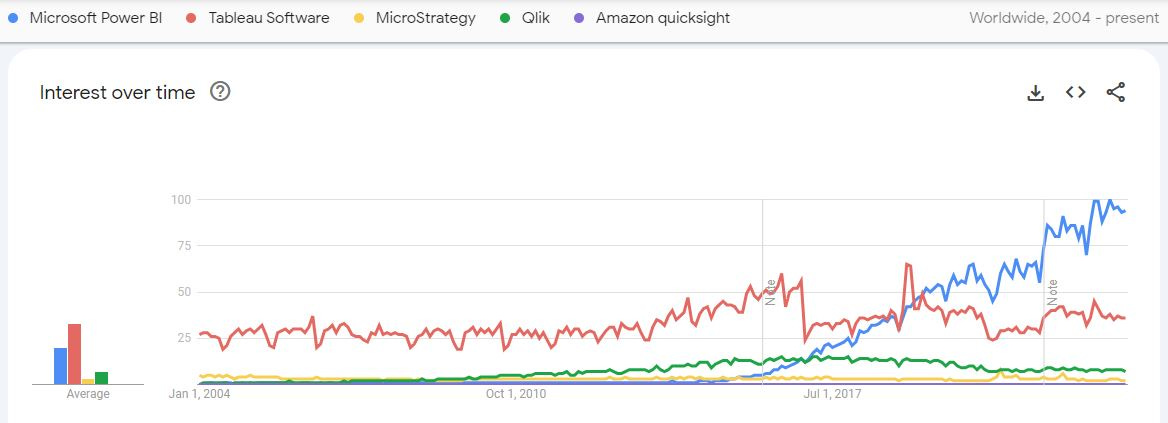🛠️ Tools #001 - Which tools are in demand for Analyst roles? 📊💼
Which Analytics Tools beginners should learn?
Happy Weekend Folks! 🌟
Today, we start with probably one of the most important areas of focus for beginners in Analytics - TOOLS! 🔧 At this point, there are numerous tools in Analytics depending on their use cases (Data Analysis, Data Science, Data Engineering, etc.), the sector (Healthcare, Insurance, Production, etc.) & the number keeps growing every day. 📊
Don’t believe me? Check out this beautiful & scary Analytics tools landscape from Matt Turck. 😅 I know, Matt has a special link on his web where you can see the full resolution version of that image. And mind you, that image is from 2021, so you can imagine how much that would change in today’s time. 📈
So, what’s the point of sharing that with you?? To demotivate you? NO!! 😊
The idea is for you to see the importance of specificity early in your career. You will probably never be able to learn all those tools, and if that makes you feel at ease, you will definitely, never need to use all of them during your lifetime. So, it’s important to learn the tools which are the basic building blocks of many new tools today. 🛠️ So, if you know the most required tools by employers, then you will already cover a big chunk of tools you need to succeed in Analytics.
What do we do then? 🤔
Well, I went ahead to LinkedIn jobs and analyzed all jobs descriptions which were posted in the past week(07 Oct 2023 - 13 Oct 2023) in USA for the role of Data Analyst.
I focused on the popular tools used in Analytics which were divided in 3-4 categories -
Data Querying - About 88% of jobs required knowledge of SQL! Clearly a MUST KNOW tool for our portfolio.
SQL (Structured Query Language) is pivotal for efficient data retrieval, manipulation, and management in databases. It empowers users to query and filter data, modify database structure, ensure data integrity, analyze information and integrate with applications.
Data Programming - About a half of them needed Analyst to know about Python programming while for R was required for about a quarter of US jobs.
Python and R are leading languages in data science. Python's versatility, readability, and extensive libraries like Pandas and scikit-learn make it highly popular. R excels in statistics and visualization with libraries like ggplot2. Python's widespread adoption in data science and its supportive community make it a smart choice for entering Analytics field and adapting to its evolving landscape.
Data Viz - The two most popular data viz or BI (Business Intelligence) tools were required for almost half of the jobs.
Power BI and Tableau are dominant players in the realm of data visualization and business intelligence. Tableau, known for its intuitive and robust visualization capabilities, has been a leader in the industry for a long time. On the other hand, Power BI, Microsoft's offering, has seen a remarkable rise in popularity due to its seamless integration with other Microsoft products, cost-effectiveness, and an evolving set of features that make it accessible to a broader audience. Power BI's growth is attributed to its user-friendly interface, ease of use, and the strong backing of Microsoft, positioning it as a competitive alternative to Tableau, appealing to businesses of all sizes.
Data Cloud - With the increase in demand for cloud computing, about a third of jobs required analyst to have knowledge about the popular cloud data warehouses like AWS (Amazon Web Services), Microsoft Azure and GCP (Google Cloud Platform). Apart from this I also wanted to make sure I capture the strong growth for a relatively new platform Snowflake which was required by about a quarter of the employers.
AWS, GCP, Azure and Snowflake are vital in cloud computing and data management. Learning these platforms is crucial for engineers as they underpin modern businesses' technology solutions. Proficiency equips engineers to design, implement and manage scalable, cost-effective and efficient cloud-based solutions, enhancing career opportunities and contributions to the evolving tech landscape.
Apart from these, I also noticed the following trends 📈 -
Very few jobs mentioned the need to know basic tools such as Excel which really means that knowledge of tools like Excel, Powerpoint is considered like basic computer skills which they for sure expect you to know. 💻
A lot of jobs required knowledge of methodologies like Agile and SAFe which makes sense because these methodologies provide a structured approach that supports adaptability, customer satisfaction, efficiency, continuous improvement, collaboration, risk management, transparency, and employee engagement. 🔄
If you would like to know more about Agile, read my newsletter! 📬 here.
But why stop here and trust my little analysis based on a weeks worth of data…
So to cover for that I went ahead to Google trends this time to measure the popularity of the tools we talked above.
Python v/s R v/s SAS -
Around 10 years ago Python overtook SAS as the preferred tool of data manipulation and exploration and never really saw back from there. As the use cases of data science, Machine learning and more recently Artificial Intelligence have come up the popularity of Python keeps on increasing. Another tool for our checklist.
Power BI v/s Tableau v/s Microstrategy v/s Qlikview v/s Amazon Quicksight -
Consistent with the Linkedin Analysis, Power BI and Tableau still stay the 2 popular BI tools which Power BI taking over Tableau near 2019. We will keep Power BI on our checklist seeing its community support and ever increasing popularity.
Other BI tools are more niche players which are popular in specific countries (for e.g - Microstrategy in France) or have never really been able to match with top 2 players.
AWS v/s Azure v/s GCP v/s Snowflake v/s Palantir
In terms of popularity, AWS has historically held a dominant position due to its early entry and extensive service offerings. Azure has gained significant traction, especially among enterprises due to its integration with Microsoft products. GCP is known for its data and analytics strengths, appealing to data-driven organizations. Snowflake is increasingly popular for its modern approach to data warehousing. Palantir, while significant in its domain, may have a slightly narrower market compared to the cloud computing platforms.
There you go!
Based on this little analysis I would be comfortable to say without having any fear on my personal bias for tools that we can focus on the following stack of tools -
SQL for Database querying
Python for Data Exploration and manipulation
Power BI for Data Viz
AWS for Cloud computing
Of course, our plan for learning is not set in stone, but this gives us a good plan for the upcoming weeks and months. 🗓️ I hope you are as excited as I am to go on this journey and learn new skills, making ourselves Analytics ready! 🚀 Please share your views on this analysis and how would you like to learn these tools?
Until Wednesday, where I will talk about the next area of our interest “MATHEMATICS”! 📚
Raghunandan 🎯
P.S. - “The Weekend Freelancer” is a reader backed publication. Share this newsletter with your friends and relatives & consider becoming a free or paid member of this newsletter. Every subscription gives me an extra ounce of motivation to keep going! 💪








